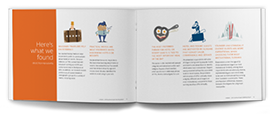Sign up for our LAVY email
and get our bi-monthly newsletter.

Personalization is everything when it comes to crafting effective marketing messages that put heads in beds for your hotel or resort. In today’s fractured hospitality industry, however, reaching everyone in your potential audience could literally mean generating hundreds of thousands of permutations of the same ad.
That’s why you need programmatic.
Simply put, programmatic advertising is a data-driven approach to dynamic digital advertising. It can be used to leverage real-time bidding (RTB) to get the best placement for your ad at the best price in online auctions to win the eyeballs of potential sales leads. Another approach, programmatic direct, guarantees ad placement with a specific publisher.
It isn’t necessary for hotel marketers to delve too deeply into the details of how programmatic advertising works beyond these two options, but the why does matter. And it goes far beyond saving money through efficiency.
Is your hotel using programmatic advertising as effectively as you could?
Let’s take a look.

Personalization isn’t just a cool aspect of programmatic advertising that can be activated. Because data drives every ad placement, it’s actually hard-baked into the strategy and bidding process.
A good programmatic trading desk will create campaigns which align specific personas based on demographic traits identified within your customer data with the most appropriate publisher (website, digital television, mobile channel or social media platform). This requires being adept at working with various data management platforms.
That’s step one.
A better programmatic trading desk can also deliver customized messaging and creative based on where the ad will publish and who will be seeing the ad. When available, psychographic data can be infused into the mix.
Unlike demographics which allow you to personalize programmatic messages based on location, gender, age and other typically used identifiers, psychographics offer insight into behavior.
Instead of asking how often your hotel guests travel, learn their attitudes and perceptions about the types of hotel amenities they most prefer when they do. Digging into their keyword search history, websites they have visited recently and online purchases they’ve made provide clues.
Travelers tend to move between devices as they complete their customer journeys. That means if you want to reach potential hotel guests looking up reviews on mobile devices during the consideration stage, you can.
For programmatic ads aimed at hotel industry consumers ready to book the perfect guest experience, consider changing up content to include discounts or special perks tied to the person viewing the ad. This could include matching them up with deals on properties which include amenities your client might not yet be aware exist in the location they plan to visit.
Creative banners, along with the guts of programmatic ads, can be custom generated on the fly as well. Multiple data points can suggest the best colors, images, verbiage and offer to present to each person. It’s something ordinary digital marketing campaigns simply cannot do.
Bear in mind that while using a couple of data points will boost results compared to using static ads to promote your travel brands, you will get the best result by incorporating as much customer information as you have available.
Combine everything you know about your customer based on your loyalty program, revenue management data and your CRM data. Include information such as how much they spend per night, how long they usually stay, and whether they order room service, or use the mini bar. In addition, consider details such as adding birthdays, anniversaries and whether they travel most for business or leisure.
Clean data, meaning you keep your CRM data accurate and current, along with your intent data, will provide the basis for real-life personas programmatic marketers need to execute personalized ad campaigns with precision. When your dynamic creative aligns with genuine insights, your hotel has the best chance of connecting the most appropriate customer experience with those who are served ads.
Ready to use programmatic to build brand awareness and bookings for your hotel or resort? LAVIDGE has worked with Sanctuary Camelback Mountain, JW Marriott Phoenix Desert Ridge Resort & Spa, Enchantment and more. Our agency can help you too.
To learn more, give us a call at 480.998.2600 or send email to info@lavidge.com.
There are many metrics you could measure, but which ones should you track?
Here’s a handy list:
Viewability – Did my programmatic ad campaign generate significant impressions?
Fraud – Were the impressions my programmatic ads generated seen by legitimate users (not bots)?
Audience – Did my ad campaign reach its intended audience?
Brand Lift – What branding impact did my campaign provide?
Bookings Lift – Did my programmatic efforts lead to more room or event bookings?
Cross-Device – Was my programmatic ad campaign able to follow users as they moved between devices?
Attribution – Which touchpoints along the customer journey contributed most to my hotel bookings?

This article is a brief abstract of our exclusive and authoritative study that takes the guesswork out of hospitality advertising and marketing. Rather than speculating about what will drive consumers to action, we've asked them.
Sign up for our LAVY email
and get our bi-monthly newsletter.